How to make a home feel unique and personal
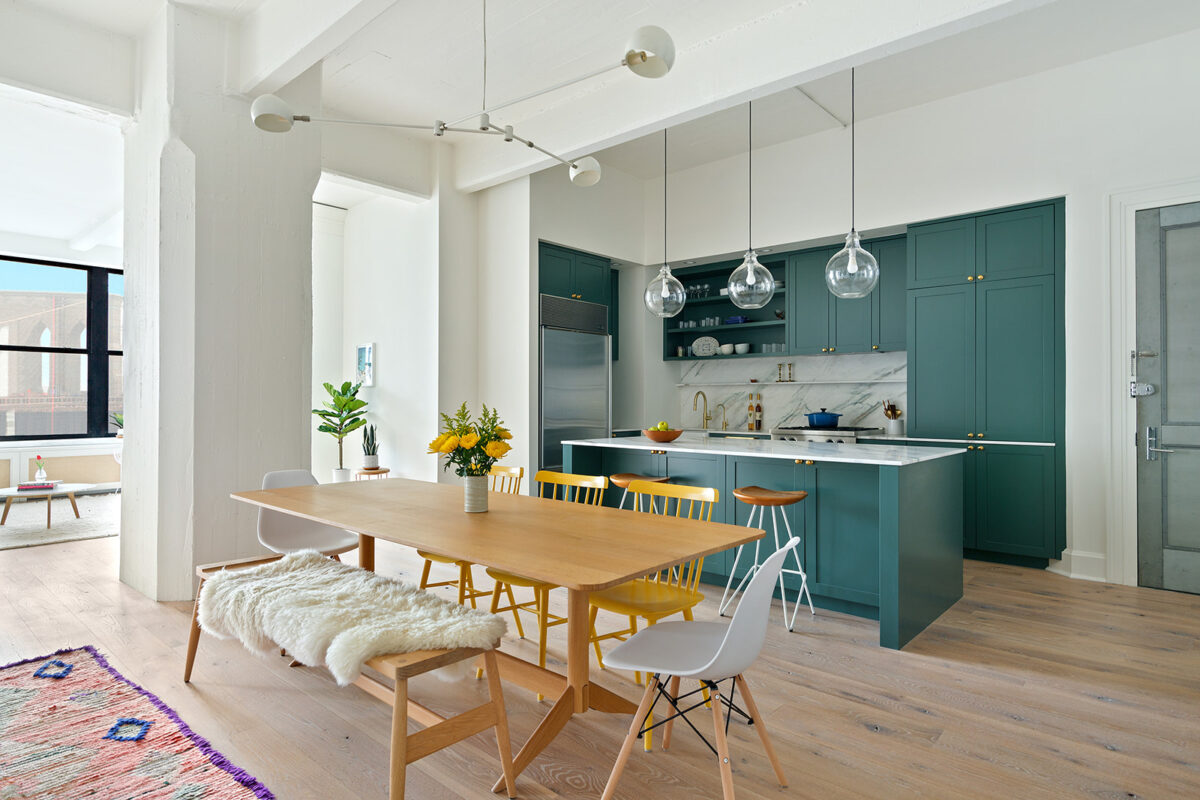
Thinking about a home refresh? Good timing! Sign ups just opened for our free LIVE home workshop, the 5 Secrets to Designing a Feelgood Home. We only do this once a year, so make sure to RSVP before spots fill up!
Does anyone plan to do a gut renovation? We certainly didn’t.
I was three months pregnant, and we knew that our loft-style one-bedroom (where I also worked from home) was going to be tricky with a third family member in the mix. Albert had been watching the listings in our building and managed to find us a bigger apartment a few floors up. The catch? The previous owner had had some interesting ideas about the space. He was an architect who had built a kind of plywood loft contraption with weird, trapezoidal angles that still give me nightmares.
While the plywood situation was the urgent issue, once we decided to renovate, we began to see other needs. The kitchen and bathrooms hadn’t been updated in awhile, so we decided we should do those. After all, once we were into the apartment, we weren’t going to want to move out to renovate those later. We might as well take care of them now, before we had the baby.
Then our realtor pointed out that we should think about converting the half-bath into a full bath. “Better for resale,” she said, and it would make it easier to bathe the kiddo.
Kitchen and bathrooms: we could’ve stopped there. But there was a weird extra door the previous tenants had cut in the bedroom that needed to be redone. As we looked at the layout, we realized that we could probably carve out space for a home office. That would be really useful, wouldn’t it? After all, I was working from home full-time and Albert often took calls there in the mornings or evenings. With a baby around, it would be nice to have some dedicated workspace.
If we were going to the trouble of redoing the kitchen and the bathrooms and tweaking the layout, wouldn’t it be nice to have new floors? We could do wide plank oak, which would look more in keeping with the style of the building, which was once an old warehouse.
And suddenly, all that was left was the ceiling. Luckily we had plenty of time before we needed to move in. After all, this was January 2020, and the baby wasn’t due until June. (Cue ominous music: Duh dun dun!)
The silver lining to a gut renovation was that we were starting with a blank canvas. We could make the space truly our own. And that’s exactly what we did. It’s ironic, of course, because after Covid hit, we made the decision to leave the city and live closer to nature. We’ll never actually live in the dream apartment we created. Still, I learned a lot from the process of designing it, particularly about how to make a space feel unique and personal.
These lessons are especially relevant for anyone renovating or building a home, but can also be applied in smaller ways in an existing space. (If you happen to be a renter, you might want to check out the post 7 Ways to Create Joy in a Rental, which will give you inspiration for personalizing a space under tighter constraints.)
So, what does it mean to design for joy from the ground up? Here are five things to keep in mind.
Design moments, not spaces
A reno begins with a rush of creativity. But after a few calls with an architect or contractor, it quickly turns into a punchlist of decisions. What kind of finish do you want on the bathroom hardware? Do you want the kitchen island centered in the space, or offset slightly? Do you want three inch or four inch handles?
These decisions aren’t trivial, of course. Add them up, and they’ll determine the overall feeling of your space. But when start to see your renovation as a list of problems to solve, you can easily lose the forest for the trees. It’s hard to know which decisions are really important and which won’t really influence your life much. As a result, you end up treating everything as important and feeling totally overwhelmed.
The thing to remember: A home is not a problem to be solved. It’s a tool for living a better life. So stop thinking about the space as a series of rooms, and start thinking about it as a series of moments in your life. When you think about a home in physical terms, your attention goes toward the stuff. You think about colors and finishes, measurements and fixtures. When you think about your home in terms of moments, on the other hand, you think about it as a canvas for living.
So instead of thinking about whether the kitchen island looks better in one position or another, you imagine trying to do your family happy dance there. Do you have enough space, or would moving it out by six inches give you the clearance you need to let loose?
Thinking about moments shapes the home to your real life. Albert and I used this approach to figure out the layout of our apartment. We often role-played different scenes from our life to imagine how they would play out depending on how we designed the space. (This always amused our architect and contractor — I highly recommend doing this for entertainment value at minimum!)
For example, I would go into the space where my office would be, and Albert would go to the front door and say, “Hey hun, I’m home!” And I’d say, “Oh great! What do you want to do for dinner?” And then he’d say, “Let’s order. I just need to take a quick call first.” and walk over to where his office would be, and we’d spend a few seconds both pretending to work. Then we’d do the alternative scenario, where my office was bigger and he took calls in the bedroom, and discuss the differences.
That’s how we ended up with two home offices, instead of just one. Carving out two offices in a New York apartment meant my workspace would be much smaller. But the life it enabled meant parity and balance — each of us had a corner of the apartment that was truly our own. No more musical chairs when we both needed to work from home. It also meant that piles of paperwork and bills that used to accumulate out in our open space now had a place to live behind a closed door. This one choice created a boundary that would protect our home lives from intrusions of work and admin.
Role-playing showed me that having a smaller workspace was a worthwhile trade for more moments of peace and calm on the infrequent occasions when Albert needed to work from home too. While it might not be a conventional decision, it was right for our life.

When redesigning any space, even just a single room, I always recommend thinking through the moments that matter most. In fact, I teach a method for using these moments to structure your space in Design a Home You Love. This role play technique is a great way to get started in envisioning how changes to your space can help shape your life for the better, whether or not you’re renovating. Try it when you’re moving furniture, reorganizing, or even just trying to find the right wall for a new piece of art.
Don’t forget to dream
A gut renovation takes an existing structure and turns it into a blank slate. Yes, there are certain things you can’t do. You can’t move load bearing walls, and it’s hard to re-route plumbing and HVAC (often impossible in a city apartment). But ultimately, when you take out the walls and pull up the floorboards, you have a universe of possibilities.
While you’d think this is freeing, in fact it can be paralyzing. Because when you can do anything, you feel unsure of everything. Where do you want the bedroom door? How wide do you want the casement to be around the interior doors? Should these recessed lighting fixtures stay or go?
What I noticed when these questions would come up is that my first reaction was often, “Well, what’s typical?” It was a way of shortcutting the process, trying to winnow the bewildering array of options down to a manageable few. But the responses often ended up being a version of “Most people do X.” In other words, a default.
There’s nothing wrong with choosing default finishes and fixtures if they’re what you really like. But what’s disappointing is when you choose a default either because you’re afraid it will seem “weird” to choose something else, or because you’re too overwhelmed to figure out what you like better.
To escape the pressure toward the default, take some time to dream. Don’t just google “best cabinet knob placement” (though there’s a time and place for that). Instead, think about places you’ve loved spending time, or places you’ve dreamed of going. Gather pictures of these places. Take note of the finishes, colors, and styles you see reflected in these images. Then consider how you might translate these ideas to your own space.

It was this kind of dreaming that led us to create built-in floor-to-ceiling shelves in the apartment, complete with brass library lighting. I’d always felt most at home in places where I could be surrounded by books. When I looked at my inspiration imagery, so many images featured built-in shelves. It wasn’t about replicating a shelving design exactly — our apartment’s dimensions meant we couldn’t do that anyway. It was about bringing the feeling of a library into our living room. We even designed custom sliding panels to hide the TV, a long-time wish I’d had that we hadn’t been able to accommodate in past homes.
Though dreaming feels like it moves you away from reality, in fact, it can help you be more concrete about your choices. Once we committed to the shelves, it was easy to figure out where the bedroom door needed to go, which in turn helped us visualize the casements and moldings. Put more simply, dreams help you prioritize. They help you design anchors that ground the space, and inform the smaller decisions.
Put feelings first
When we decided to replace the kitchen, I knew a big choice was looming: what color would we make the kitchen cabinets? An open kitchen like ours often acts as a hub for the home. We could see it from most rooms of the house. It felt like a lot of pressure was riding on this decision.
This is the point when most of us turn to Pinterest. We might look for “trending kitchen colors” or “classic kitchen colors” or “bold kitchen colors” and end up on one of those slideshows, swiping through photo after photo after photo. The problem with this is that it orients your attention outward, filling your mind with other people’s ideas about kitchens before you’ve gotten a handle on your own. You’re attracted to an image because of the feeling it creates, but replicating that feeling in your own space isn’t as simple as choosing the same colors and finishes. Whenever I’ve done this, I’ve ended up with a weak imitation of what I was hoping to achieve.
The trick to creating something truly unique is to turn your attention back inward. Ask yourself: How do I want to feel in this space?
When designing the apartment, Albert and I had lots of conversations about this. One thing we kept coming back to was the idea of feeling free and calm. We’d been enjoying our time out of the city so much, and to be honest, the transition back to the city on Sunday night or Monday morning often felt jarring. How could we create an oasis that felt liberating in a dense urban setting?
We settled on the freedom aesthetic as our primary focus for the space. When trying to figure out a specific element of the design, we’d ask: What would make us feel free?
For the offices, this meant designing an interior glass wall inspired by greenhouses that lets light in and makes the small interior spaces feel open and airy. For the kitchen, it meant exploring shades of blue and green. After seeing a first round of swatches, we quickly landed on green as the hue that brought more of a sense of nature into a highly manufactured space.
This approach isn’t limited to renovations at all. Whenever you are changing your space, take a moment to jot down a few words for how you want your space to feel. I can promise that the ideas you uncover will be much more inspiring, and much more YOU, than anything you can find on Pinterest.

Get hands-on
The process of creating a home can be weirdly abstract. Yes, you’re dealing with physical materials like tile, stone, and wood, but often you’re making choices about these things by seeing tiny images of them in catalogs or on your computer screen.
I don’t have to tell you to get samples of your finishes before committing to them. (Though if the reminder helps, let me just say there is little more heart-wrenching in a renovation than to open a box of wallpaper that cost a small fortune only to discover that the color is totally different than you’d imagined — and not in a good way.) But beyond just getting samples, it can help to get more physically involved in the process of making your home yours.
What could this look like? For us, it meant visiting a stone yard to choose the stone for our kitchen counters, rather than just choosing from a website. At the stone yard, we were able to see materials our contractor never would’ve thought to tell us about, and choose the exact piece we would use in our kitchen. (The stone we chose is called Bianca Lasso.) This is another way to get past the default. In kitchens, it’s become commonplace to use Carrara or Calacatta marble, but there are literally dozens of other stone options that have more interesting character to give a home. It’s a little like the way that there are only two kinds of tomato at most grocery stores — beefsteak or vine-ripened — but if you go to a local farm you’ll find all kinds of heirloom varieties that each have their own quirks and virtues.
Similarly, when I was struggling to find the right green for the kitchen, my friend Rebecca Atwood, the textile designer, tipped me off to the fact that Benjamin Moore will custom mix a color for you based on a swatch. I sat down with some gouache and mixed up a range of greens, trying to get at a color that gave us that freeing feeling. I befriended Kenny at the paint store and soon had a few sample cans of my custom mixed paints. I ended up going with a standard color (BM Lafayette Green), but it was one that I had completely overlooked on my first round because it seemed too blue. I would never have found that color if I hadn’t first gone rogue and sought out my own.

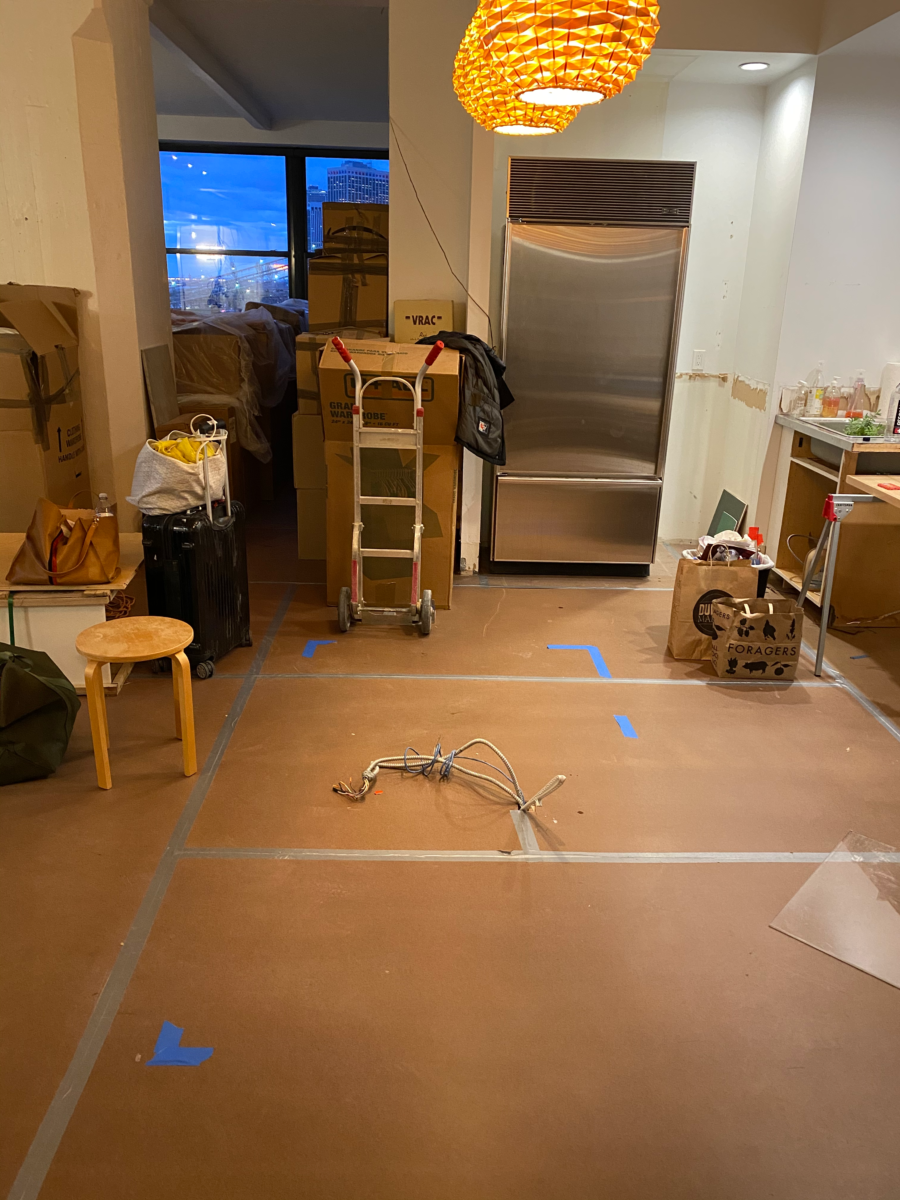
You can also get hands on when it comes to the composition of your space. Albert and I often went to the apartment with a roll of blue tape, testing out locations of doors and toilets, and the heights of light fixtures and mirrors. In the image above, we were testing out dimensions for the kitchen island, figuring out the ideal distance from the door and that all-important happy dance zone! More often than not, we would discover that the dimensions marked on the plans felt awkward in real life. If we hadn’t gone through the work of taping it out, we would’ve ended up with space that felt subtly off.
My most hands-on moment, though, had to be arranging the tile for the hall bath while five months pregnant. The tile we chose has six different variations, and each can be placed right side up or upside down. Rather than leave this up to chance or ask our tile guy to interpret a mockup, we laid each tile in place on the floor so that he could simple transfer the design to the bathroom wall.
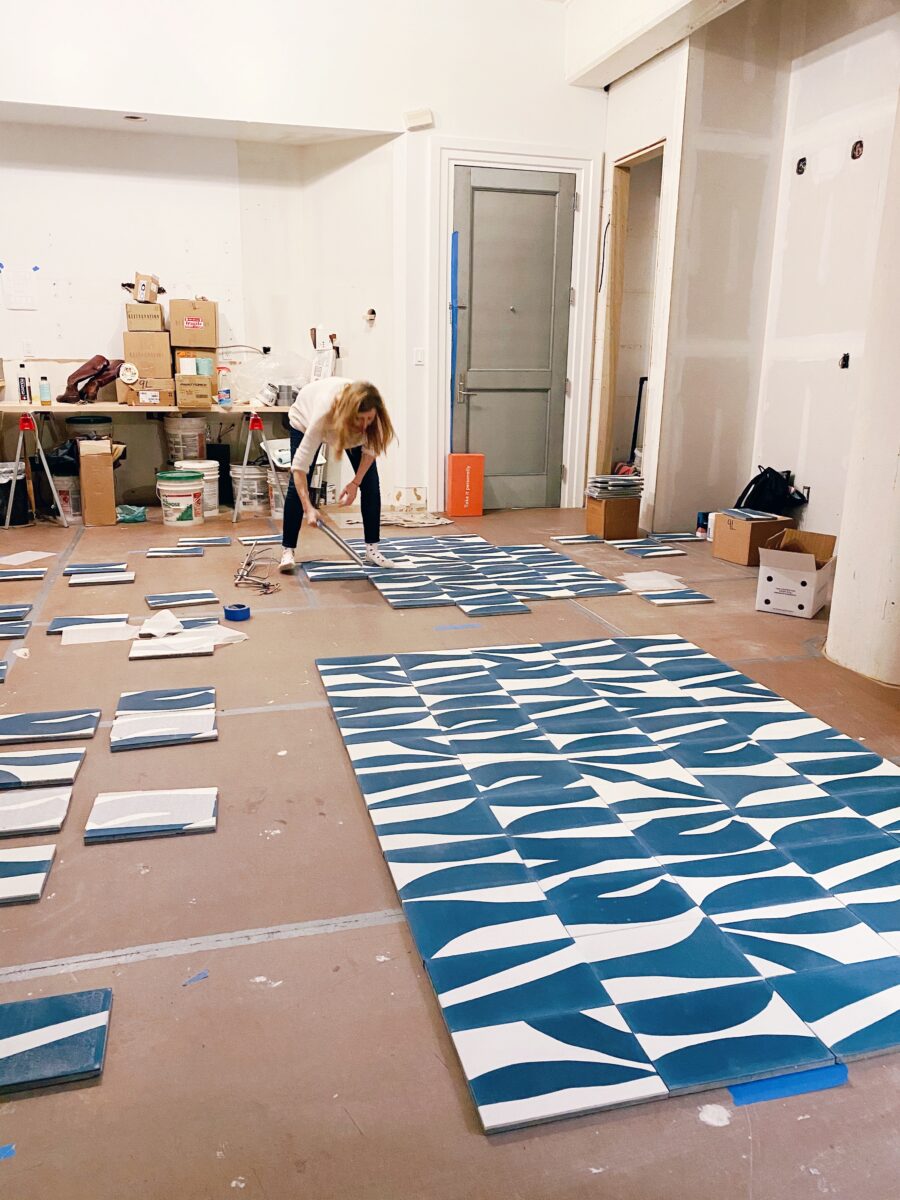
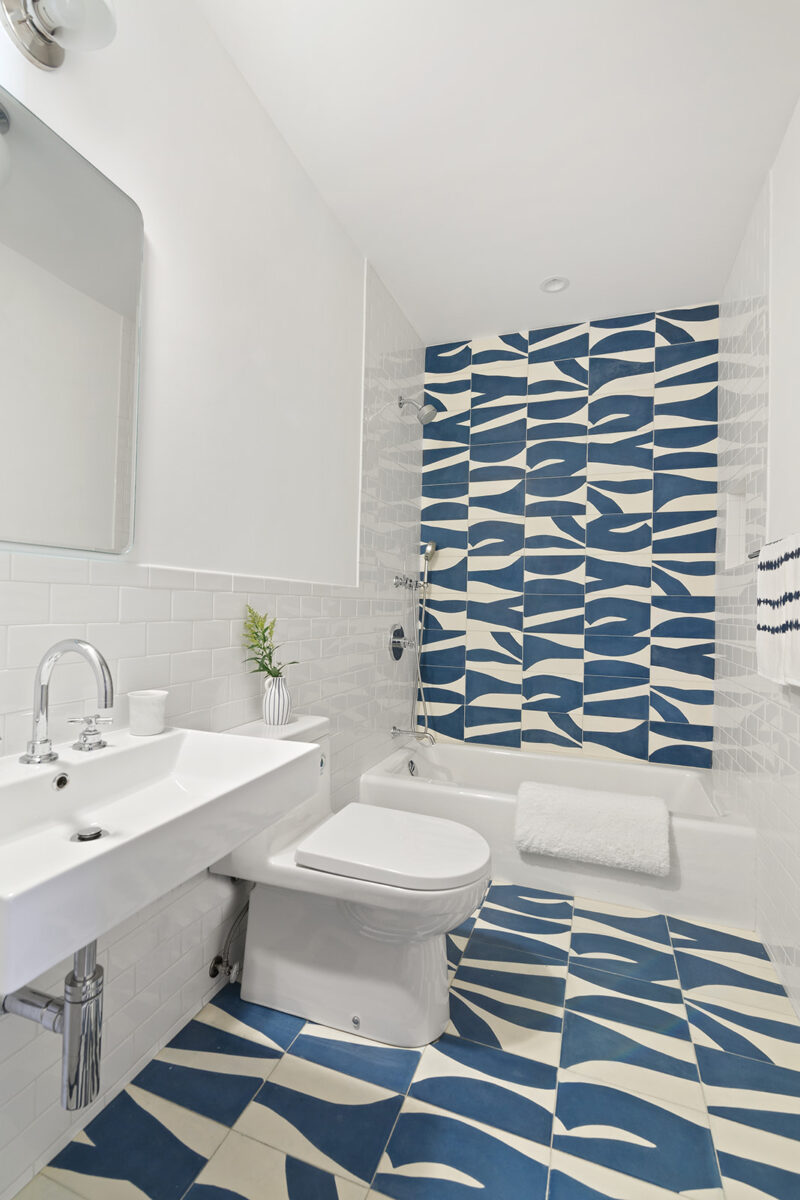
Create continuity between old and new
If you’re ready for a change, a gut reno can feel like an opportunity to start from scratch, leaving behind things you got tired of in your old space and imagining something totally new. But even so, it’s worth looking for ways to bring elements from your old space into your new one.
In our case, our old apartment was being gutted so our neighbor could combine it with his place, so we were able to bring our old built-in shelving and desks into the new space. But since I wanted a new style of built-in, and the dimensions were different, we didn’t want to just put the old shelves up in the living room. Instead, we had our contractor cut them down to fit our offices.
I didn’t think this would matter much, but when I walked into the finished offices for the first time, it felt so welcoming to see the soft textures of those shelves. They bridged the old space to the new, and made it feel even more like home.


Ultimately, a home becomes your own through a process of investing yourself in it. This means being clear with yourself about what you really want and building from there, rather than taking cues from others — whether that’s your architect, contractor, or some influencer on the internet. This can be hard to do. There are so many voices telling us what we should want, what’s popular, or what’s in, and so many pressures to make a decision and keep the process moving.
But it takes less time than you think to dream, role play, feel, and explore materials. And more than just creating a more unique home, these processes become part of the story that makes the place yours.
When I look at our Brooklyn apartment, one thing that strikes me is that even though we didn’t furnish it (some of what you see in these photos is staged by our realtor), it still feels like us. That happened because little decisions like floor finishes and radiator covers and jib doors and moldings came from our original intention to create an airy, freeing oasis in the city.
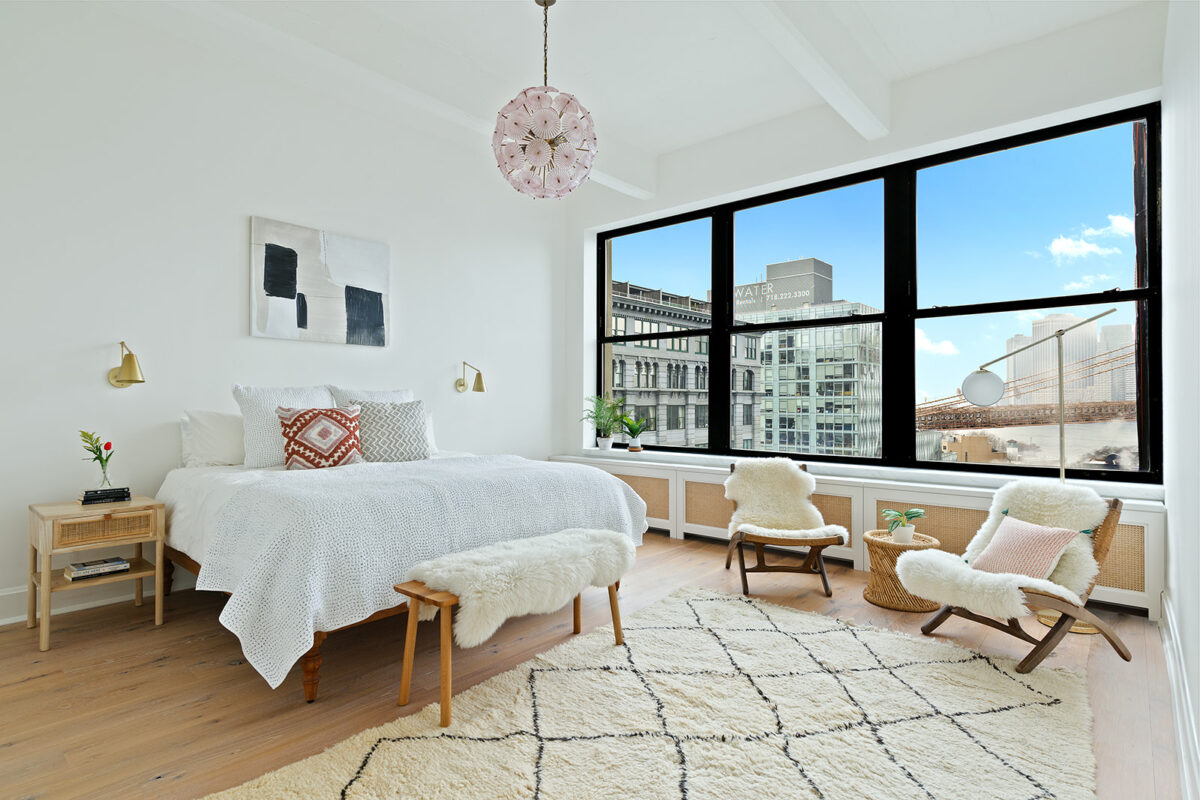
When I tell people we’re selling, I’m often asked if I’m sad that I won’t get to live in the dream apartment. There’s a little sadness, I suppose, but mostly I’m happy we created it. Every time I go to check in on it, I have this feeling like, “Damn, this place feels so good.” I do think it looks nice in pictures, but there’s something you get from being there that can’t be captured in a photo. I hope its new owners will feel that same ease when they walk in the door, and get the sense of refuge we envisioned when our lives were so hectic that we needed that quiet oasis within the sleepless city.
As for us, there are new dreams now. And they all start with a feeling…
Reminder: My free live home workshop is coming soon! Learn how to create a home you love without moving, renovating, or spending money you don’t have. Save your seat right here.
Do you have any questions about our renovation? Share them in the comments below!





Discussion (4 Comments)
Great post!
The green on your cabinets is lovely, a touch of blue and not too sage-y or bright. But your photo looks quite a bit lighter than the chip for Lafayette Green. Did you use full strength or lower strength?
I love your tile also. Many were telling me to go “classic” on my baths (i.e. boring, lol). I chose to go boldly with what I love, while keeping the rest plain like you did. I think many people make the mistake chickening out of bold, but instead they combine too many ideas and make things too busy. I think a bright colored or patterned bath with a single tile is much more classic and appealing than a smattering of ideas which usually clash and are too busy.
Yes! I love your perspective on tile. It’s so fun to go bold if you can!
As for the color, it’s full strength! It looks a little bit darker in person, I would say – this was shot on a very sunny day!
Your posts have come at a perfect time for us. We have been half heartedly house hunting for 3 years whilst I work from home at my bedside table. After a panic attack over a house viewing we finally decided to stay put. We are having an office built in the garden that will be big enough for me to do my Pilates and for a sofa bed for guests. We are so excited and having conversations about bold paint choices and how to inject “us” into our home after totally depersonalising the house for sale. Choices can be overwhelming so loving your idea about how you want a space to make you feel!
Ingrid, I love the spaces you created and showed here. Who’s the author of posters in your workspace?